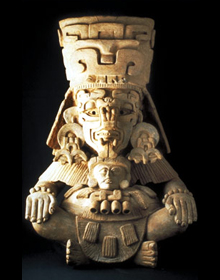resources
Museum Collections - Mesoamerica - Zapotec

The Zapotec civilization arose in the Mexican valley of Oaxaca around 500 B.C. It reached its height of artistic and political influence between A.D. 200 and 700. As a society it was sharply divided along class lines, between nobility and more common folk.
The Zapotec elite governed the territories they controlled from a large and architecturally impressive urban centre known as Monte Albán, which supported a large population during its peak. Archaeologists use different phases of the site's development to date and contextualize Zapotec artifacts. Monte Albán's core was built upon a levelled mountain top with residential structures located upon terraces constructed down the hillside. By A.D. 700, Zapotec power waned and the population of Monte Albán began to desert the city.
While the Zapotec state may have disappeared at this time, the people did not. Over 1200 years have passed since the artifacts featured here were formed and the descendants of the ancient Zapotec still live in their homeland, in the modern state of Oaxaca, Mexico.


